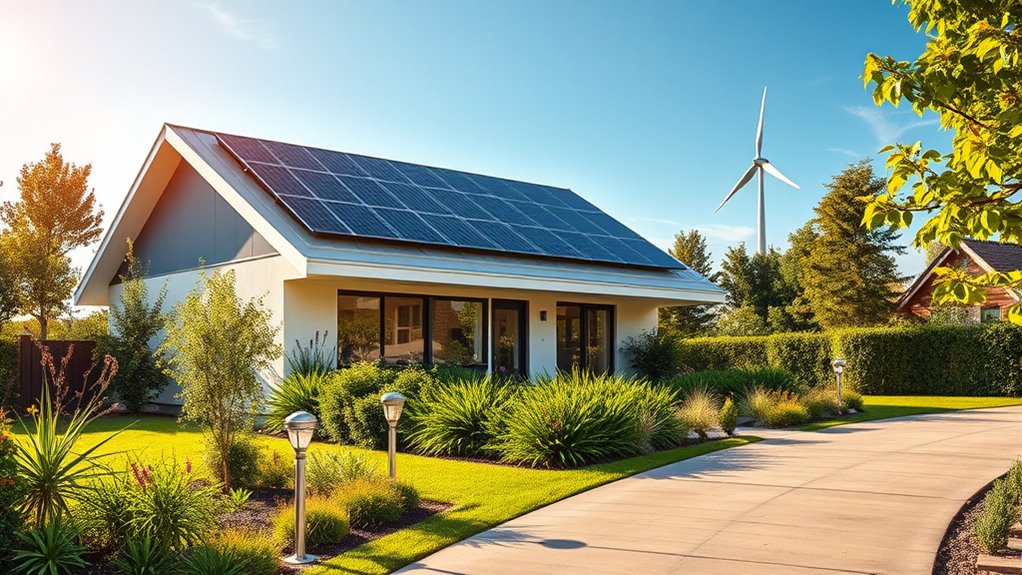Upgrading your home with energy-efficient solutions can lower your utility bills and shrink your carbon footprint. Smart thermostats learn your schedule and optimize heating and cooling for maximum comfort and savings. Installing solar panels lets you harness renewable energy, reducing reliance on fossil fuels and adding value to your property. Together, these upgrades create a greener, more sustainable home while you save money long-term. Keep exploring to discover how you can make your house more efficient and eco-friendly.
Key Takeaways
- Installing smart thermostats enhances energy efficiency by learning schedules and remotely adjusting temperatures to reduce waste.
- Solar panel installations generate renewable energy, lowering electricity bills and decreasing reliance on fossil fuels.
- Combining solar panels with smart thermostats optimizes energy use, maximizing savings and environmental benefits.
- Upgrading to energy-efficient appliances and insulation helps reduce overall energy consumption and carbon footprint.
- These upgrades increase property value while supporting long-term financial savings and a sustainable future.

Upgrading your home for energy efficiency not only reduces your carbon footprint but also lowers your utility bills. One of the simplest and most effective ways to start is by installing a smart thermostat. Unlike traditional thermostats, smart thermostats learn your schedule and preferences, automatically adjusting the temperature for ideal comfort and energy savings. With remote access via your smartphone, you can control your home’s temperature from anywhere, ensuring you’re not wasting energy when you’re away. Many models also provide detailed energy reports, helping you identify patterns and further refine your usage. This small investment can lead to significant savings over time, especially when paired with other upgrades.
Another powerful upgrade is solar panel installation. While it requires a larger upfront investment, solar panels generate clean, renewable energy that can drastically cut your electricity bills. As technology has advanced, solar panel efficiency has improved, making it more feasible for homeowners to harness the sun’s power. Installing solar panels not only reduces your reliance on fossil fuels but also increases the value of your property. Many regions offer incentives, tax credits, or rebates that can offset the initial costs, making solar more accessible. Once installed, you’ll notice a decrease in your monthly energy expenses, and over the long term, you’ll benefit from stable energy costs and potential income through net metering.
Combining these two upgrades maximizes your home’s energy efficiency. A smart thermostat ensures you’re only using energy when needed, avoiding wasteful heating or cooling. Meanwhile, solar panels produce the renewable energy that powers your home, making your entire system more sustainable. You’ll also enjoy the peace of mind that comes with knowing you’re reducing your environmental impact. These technologies are designed to integrate seamlessly into your home, often controlled via intuitive apps, making it easy to monitor and adjust your energy use.
Beyond savings and sustainability, these upgrades contribute to a more comfortable living environment. A smart thermostat maintains consistent temperatures, preventing hot or cold spots, while solar energy supports a quieter, cleaner home operation. Plus, as the grid becomes greener and more efficient, your home’s overall carbon footprint continues to shrink. Additionally, being aware of spoilage signs in your appliances or systems can help maintain their efficiency and prolong their lifespan. Implementing these upgrades is a proactive step toward a more sustainable future, saving you money while helping to protect the planet. With the right choices, you can enjoy a more energy-efficient, eco-friendly home that aligns with your values and financial goals.
Frequently Asked Questions
What Grants or Incentives Are Available for Energy-Efficient Home Upgrades?
You can take advantage of various grants and incentives for energy-efficient home upgrades. Many programs, including government rebates, help offset costs for installing renewable energy systems like solar panels or upgrading insulation. These incentives make it easier for you to save money while reducing your environmental impact. Be sure to check local, state, and federal programs, as eligibility and offerings vary, but they’re designed to support your efforts toward a greener, more efficient home.
How Long Does It Typically Take to See Financial Savings After Upgrades?
Like planting a seed that blooms over time, your upgrades start saving you money quickly. Typically, you see a positive payback period within 3 to 7 years, depending on your home and upgrades. The savings timeline varies, but most homeowners notice reduced energy bills within the first few months. Keep track of your energy use to see the gradual growth of your savings, making your investment worthwhile.
Are There Specific Home Types That Benefit Most From These Upgrades?
Certain home types, like apartment buildings and historic homes, benefit most from energy-efficient upgrades. Apartments can see significant savings due to shared heating and cooling, while historic homes often need tailored solutions to preserve their charm. If you own one of these, investing in upgrades can reduce your energy bills and improve comfort. Understanding your home’s unique features helps you choose the best upgrades for maximum benefits.
Can Energy-Efficient Upgrades Increase My Home’s Resale Value?
Imagine your home’s value skyrocketing just when you’re ready to sell. Upgrades like solar panels and energy-efficient windows can do that, boosting your home appraisal and shifting market perception. These improvements make your house more attractive to buyers, showing you’re committed to sustainability. As a result, your home’s resale value can increase, giving you a stronger position in negotiations and a higher return on your investment.
What Maintenance Is Required for Energy-Efficient Systems?
To keep your energy-efficient systems running smoothly, you should perform routine inspections and system tune-ups regularly. These tasks help identify potential issues early, improve efficiency, and extend the lifespan of your equipment. By staying proactive with maintenance, you guarantee ideal performance and save money on costly repairs in the long run. Make sure to follow the manufacturer’s guidelines and schedule professional check-ups at least once a year.
Conclusion
By making energy-efficient upgrades, you not only save money but also protect the planet. Small changes add up over time, proving that every effort counts. Remember, “A penny saved is a penny earned,” so investing in your home’s efficiency pays off in more ways than one. Embrace these upgrades today, and you’ll enjoy a greener, more cost-effective future. After all, sustainability begins with you—one smart choice at a time.









